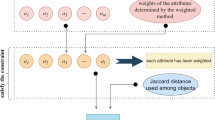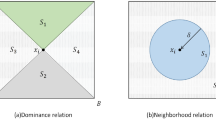Abstract
Dominance-based neighborhood rough set (DNRS) is capable to give qualitative and quantitative descriptions of the relations between ordered objects. In spite of its effectiveness in feature selection, DNRS ignores the various significance of features. In fact, different features exert different impacts on decision-making. Once we explore these differences in advance, it is easier to find out features with high correlation and dependency. Likewise, it is inevitable that in big-data era the objects may update from time to time, which calls for efficient attribute reduction. However, the existing approaches are inappropriate for the weighted and ordered data. Motivated by these two deficiencies, first, we assign different weights to conditional attributes and establish the weighted dominance-based neighborhood rough set (WDNRS). Then a kind of conditional entropy in matrix form and ensuing updating principles are put forward to evaluate the significance of the attributes. In addition, grounded on the entropy, we come up with the heuristic algorithm and corresponding incremental mechanism when objects increase. Finally, twelve experiments are carried out to verify that it is effective and efficient for the designed method to select features in dynamic datasets.






Similar content being viewed by others
References
Zhong J, Wang J, Peng W, Zhang Z, Li M (2015) A feature selection method for prediction essential protein. Tsinghua Sci Technol 20(5):491–499
Bang S, Kang J, Jhun M, Kim E (2017) Hierarchically penalized support vector machine with grouped variables. Int J Mach Learn Cyb 8(4):1211–1221
Abedini M, Kirley M (2013) An enhanced XCS rule discovery module using feature ranking. Int J Mach Learn Cyb 4(3):173–187
Gu S, Cheng R, Jin Y (2018) Feature selection for high-dimensional classification using a competitive swarm optimizer. Soft Comput 22(3):811–822
Pilyugina N, Tsukahara A, Tanaka K (2021) Comparing methods of feature extraction of brain activities for octave illusion classification using machine learning. Sensors 21(19):6407–6407
Ali W (2017) Phishing website detection based on supervised machine learning with wrapper features selection. Int J Adv Comput 8(9):72
Tuo Q, Zhao H, Hu Q (2018) Hierarchical feature selection with subtree based graph regularization. Knowl-Based Syst 163:996–1008
Roffo S, Melzi S, Castellani U, Vinciarelli A, Cristani M (2020) Infinite feature selection: a raph-based feature filtering approach. IEEE Trans Pattern Anal 43(12):4396–4410
Pawlak Z (1982) Rough sets. Int J Comput Inform Sci 11(5):341–365
Yao Y (1998) Relational interpretations of neighborhood operators and rough set approximation operators. Inform Sci 111(1–4):239–259
Ziarko W (1993) Variable precision rough set model. J Comput Syst Sci 46(1):39–59
Greco S, Matarazzo B, Slowinski R (1999) Rough approximation of a preference relation by dominance relations. Eur J Oper Res 117(1):63–83
Wang P, Wu Q, He J, Shang X (2018) Approximation operator based on neighborhood systems. Symmetry-basel 10(11):539–539
Hu Q, Yu D, Me Z (2008) Neighborhood classifiers. Expert Syst Appl 34(2):866–876
Sun L, Zhang X, Qian Y, Xu J, Zhang S (2019) Feature selection using neighborhood entropy-based uncertainty measures for gene expression data classification. Inform Sci 502:18–41
Sun L, Yin T, Ding W, Qian Y, Xu J (2022) Feature selection with missing labels using multilabel fuzzy neighborhood rough sets and maximum relevance minimum redundancy. IEEE Trans Fuzzy Syst 30(5):1197–1211
Sun L, Li M, Ding W, Zhang E, Mu X, Xu J (2022) AFNFS: Adaptive fuzzy neighborhood-based feature selection with adaptive synthetic over-sampling for imbalanced data. Inform Sci 612:724–744
Greco S, Matarazzo B, Slowinski R (2001) Rough sets theory for multicriteria decision analysis. Eur J Oper Res 129(1):1–47
Zhang X, Chen D, Tsang E (2016) Generalized dominance rough set models for the dominance intuitionistic fuzzy information systems. Inform Sci 378:1–25
Ali A, Ali MI, Rehman N (2019) Soft dominance based rough sets with applications in information systems. Int J Approx Reason 113:171–195
Chen H, Li T, Luo C, Hu J (2015) Dominance-based neighborhood rough sets and its attribute reduction. Rough sets and knowledge technology, lecture notes in computer science. Springer, Berlin, Heidelberg, pp 89–99
Chen H, Li T, Cai Y, Luo C, Fujita H (2016) Parallel attribute reduction in dominance-based neighborhood rough set. Inform Sci 373:351–368
Wan J, Chen H, Yuan Z, Li T, Yang X, Sang B (2017) A novel hybrid feature selection method considering feature interaction in neighborhood rough set. Knowl-Based Syst 227:107167
Wang S, Li X, Xia J, Xia J, Zhang X (2010) Weighted neighborhood classifier for the classification of imbalanced tumor dataset. J Circuit Syst Copm 19(1):259–273
Tsang E, Hu Q, Chen D (2016) Feature and instance reduction for PNN classifiers based on fuzzy rough sets. Int J Mach Learn Cyb 7(1):1–11
Hu M, Tsang E, Guo Y, Chen D, Xu W (2021) A novel approach to attribute reduction based on weighted neighborhood rough sets. Knowl-Based Syst 220:106908
Liang J, Wang F, Dang C, Qian Y (2014) A group incremental approach to feature selection applying rough set technique. IEEE Trans Knowl Data En 26(2):294–308
Sang B, Chen H, Yang L, Zhou D, Li T, Xu W (2021) Incremental attribute reduction approaches for ordered data with time-evolving objects. Knowl-Based Syst 212:106583
Sang B, Chen H, Yang L, Li T, Xu W (2022) Incremental feature selection using a conditional entropy based on fuzzy dominance neighborhood rough sets. IEEE Trans Fuzzy Syst 30(6):1683–1697
Yuan K, Xu W, Li W, Ding W (2021) An incremental learning mechanism for object classification based on progressive fuzzy three-way concept. Inform Sci 584:127–147
Jing Y, Li T, Huang J, Zhang Y (2016) An incremental attribute reduction approach based on knowledge granularity under the attribute generalization. Int J Approx Reason 76:80–95
Chen D, Dong L, Mi J (2019) Incremental mechanism of attribute reduction based on discernible relations for dynamically increasing attribute. Soft Comput 24(1):321–332
Dong L, Chen D (2020) Incremental attribute reduction with rough set for dynamic datasets with simultaneously increasing samples and attributes. Int J Mach Learn Cyb 11(6):1339–1355
Zhang X, Chen X, Xu W, Ding W (2022) Dynamic information fusion in multi-source incomplete interval-valued information system with variation of information sources and attributes. Inform Sci 608:1–27
Xu W, Yuan K, Li W (2022) Dynamic updating approximations of local generalized multi-granulation neighborhood rough set. Appl Intell 52(8):9148–9173
Huang Y, Li T, Luo C, Fujita H, Horng S (2017) Matrix-based dynamic updating rough fuzzy approximations for data mining. Knowl-Based Syst 119:273–283
Wang S, Li T, Luo C, Fujita H (2016) Efficient updating rough approximations with multi-dimensional variation of ordered data. Inform Sci 372:690–708
Wang S, Li T, Luo C, Chen H, Fujita H (2019) Domain-wise approaches for updating approximations with multi-dimensional variation of ordered information systems. Inform Sci 478:100–124
Shannon C, Weaver W (1948) The mathematical theory of communication. Bell Syst Tech J 27(3/4):373–423
Hu Q, Yu D, Xie Z, Liu J (2006) Fuzzy probabilistic approximation spaces and their information measures. IEEE Trans Fuzzy Syst 14(2):191–201
Hu Q, Che X, Zhang L, Zhang D, Guo M, Yu D (2012) Rank entropy-based decision trees for monotonic classification. IEEE Trans Knowl Data En 24(11):2052–2064
Yuan Z, Chen H, Yang X, Li T, Liu K (2021) Fuzzy complementary entropy using hybrid-kernel function and its unsupervised attribute reduction. Knowl-Based Syst 231:107398
Acknowledgements
This paper is supported by the National Natural Science Foundation of China (NO. 61976245).
Author information
Authors and Affiliations
Corresponding author
Additional information
Publisher's Note
Springer Nature remains neutral with regard to jurisdictional claims in published maps and institutional affiliations.
Rights and permissions
Springer Nature or its licensor (e.g. a society or other partner) holds exclusive rights to this article under a publishing agreement with the author(s) or other rightsholder(s); author self-archiving of the accepted manuscript version of this article is solely governed by the terms of such publishing agreement and applicable law.
About this article
Cite this article
Pan, Y., Xu, W. & Ran, Q. An incremental approach to feature selection using the weighted dominance-based neighborhood rough sets. Int. J. Mach. Learn. & Cyber. 14, 1217–1233 (2023). https://doi.org/10.1007/s13042-022-01695-4
Received:
Accepted:
Published:
Issue Date:
DOI: https://doi.org/10.1007/s13042-022-01695-4




